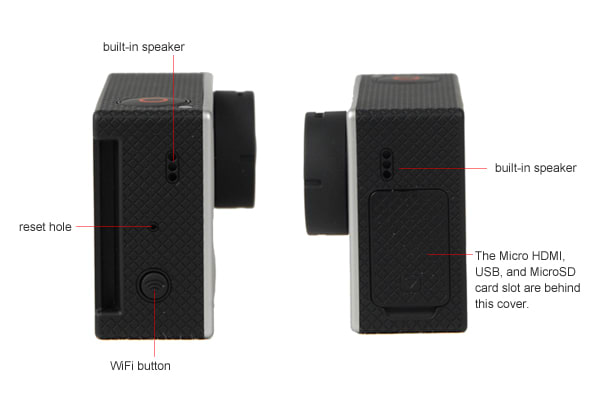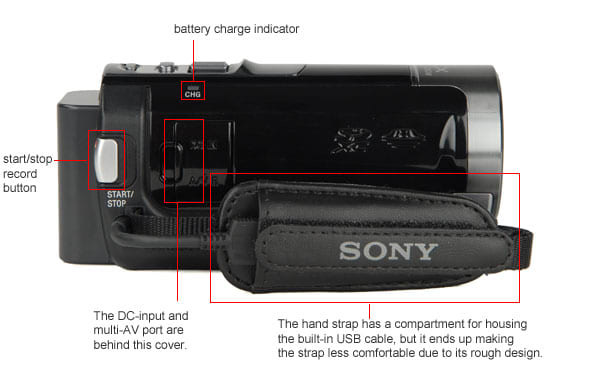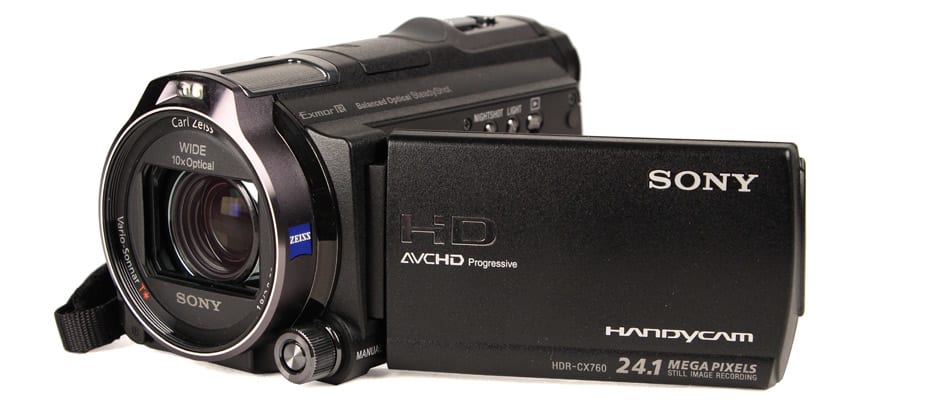Pros
Cons
Introduction
The HDR-CX760V is currently available for around $1299, which is a significant price drop from it launch-date $1499 MSRP. Loaded with 96GB of internal flash memory, this is a reasonable price to pay for a flagship Handycam, but it's certainly not cheap. You do have the option of saving a few bucks and going with the similar HDR-PJ710V instead. This model doesn't have a viewfinder, only has 32GB of internal memory, but comes with a built-in projector instead (with an MSRP of $1149). And if you want a fully-loaded model, Sony has its top-line HDR-PJ760V that has everything: 96GB of internal memory, a viewfinder, and the built-in projector. In the end, with think the HDR-CX760V is the best value, especially since all these camcorders are essentially identical under the hood.
Video Review
{{section_header}}{{section.name}}{{/section_header}}
Design
The Sony HDR-CX760V looks and feels nearly identical to the last Sony camcorder we reviewed, the HDR-PJ710V. But there are three key differences: the CX760V has no built-in projector on the back of its LCD panel, but it does have a built-in electronic viewfinder and three times as much internal memory as its sibling model. The lack of the built-in projector does make the CX760V a bit lighter and, as a result, easier to grip. It's not a huge difference by any means, but it is noticeable after spending a bit of time with both camcorders. The viewfinder on the HDR-CX760V doesn't have a spectacular design, but just the presence of a viewfinder on a consumer camcorder is worth recognition these days. And it certainly does help if you're shooting video on a bright, sunny day where the LCD is unusable due to glare.
Front
{{section_header}}{{section.name}}{{/section_header}}

Back
{{section_header}}{{section.name}}{{/section_header}}

Left
{{section_header}}{{section.name}}{{/section_header}}

Right
{{section_header}}{{section.name}}{{/section_header}}

Top
{{section_header}}{{section.name}}{{/section_header}}

Bottom
{{section_header}}{{section.name}}{{/section_header}}

In the Box
{{section_header}}{{section.name}}{{/section_header}}
The Sony Handycam HDR-CX760V comes with the following:
• Lens hood
• Power cord
• USB extender cable
• Step down ring
• NP-FV50 rechargeable battery pack
• Multi-AV cable
• Software CD
• AD adaptor
• Mini HDMI cable
• Remote control
Performance
There aren't too many negatives with the Sony HDR-CX760V's video performance. The camcorder's 1080/60p video mode captures excellent video in bright light that is sharp, fluid, and very clean. In low light, the camcorder struggled a bit in very dark environments, but its images were still vivid, with little presence of noise. We can't say it is the best low light camcorder we've ever seen, but the HDR-CX760's complete repertoire in our performance testing was impressive to say the least. This is a camcorder without any major performance flaws: good sharpness, good color, excellent image stabilization, and low noise levels. If you're looking for top-notch video from a consumer camcorder, this is your guy.
Color
{{section_header}}{{section.name}}{{/section_header}}
The quality of color may be in the eye of the beholder—what looks pleasing to you may not look pleasing to your neighbor—but the Sony HDR-CX760V did a couple things undeniably well in our color test. It's tones were deep and vivid, measuring a 94% saturation level, and its colors were quite accurate (earning a 4.03 color error in our test). And judging by our eyes, the colors captured by the Sony simply looked good. More on how we test color.
Most camcorders in the high-end category do very well on our color tests in bright light. All of the models we compared the Sony CX760V to had color error scores of around 4.0 or lower, and all had saturation levels 85% and higher. It should also be noted that it's not hard to tweak the colors on your video using editing software (or even a video hosting service like YouTube). So, if you don't like the colors your camcorder produces, you can always tweak them later if you're dedicated.
{{comparison_bars title="Color Score Comparison", attribute="Color Score", xLabel="Color Score"}}
Low Light Color
{{section_header}}{{section.name}}{{/section_header}}
Color accuracy took a bit of a dip in low light for the Sony CX760V, but the video images still looked quite good. The camcorder's color error measured at 4.48 and the saturation level was a cool 79%. These numbers, particularly the saturation level, are down from the CX760V's bright light color results, but they're in the same ballpark as the rest of the high-end models we compared it to. More on how we test low light color.
Noise
{{section_header}}{{section.name}}{{/section_header}}
Noise levels on the HDR-CX760V in bright light, as is the case on most high-end models, were very low. The levels measured 0.535%, which is essentially identical to the levels we saw on the HDR-PJ710V. That makes sense, as the PJ710V has the same lens, sensor, and guts as the CX760V. More on how we test noise.
{{comparison_bars title="Noise Score Comparison", attribute="Noise Score", xLabel="Noise Score"}}
Low Light Sensitivity
{{section_header}}{{section.name}}{{/section_header}}
Sensitivity was probably the biggest area of improvement for the HDR-CX760V this year (as compared to last year's CX700V). Without using any zoom, the camcorder needed just six lux of light to record an image deemed bright enough for broadcast. That's a pretty low light level, so you should be able to film decent images in a dimly-lit bar or bedroom with this camcorder. Using zoom, the CX760V needs more light to record the same kind of images, only because using zoom closes down the camcorder's aperture a bit. In our second sensitivity test, where we frame our test chart using zoom, the camcorder needed 17 lux of light to record a decently-bright image. More on how we test low light sensitivity.
While these results are a strong improvement over last year, they're not quite as good as the results we saw from the Canon HF G10. The Panasonic HC-X900M also had a bit of an edge over the Sony, but not by much. But the Sony's overall low light numbers (including color and noise) were also quite good, and these three tests combined to put forth a very good low light performance.
{{comparison_bars title="Low Light Sensitivity Comparison", attribute="Low Light Sensitivity Score", xLabel="Low Light Sensitivity Score"}}
Low Light Noise
{{section_header}}{{section.name}}{{/section_header}}
The Sony HDR-CX760V produced images in low light that were mostly noise free. In our low light test we shoot using 60 lux of light, which is about what you'd get from a bedroom or living room with a single lamp turned on. With this kind of light, the noise levels came to 0.6%, and anything under 1.0% in this test is very good. Using even less light, the CX760V will start to produce a noisier image, but that's what we see from most consumer camcorders. The benefit of the Sony, however, is that it has many low light video options. There's the infrared Nightshot that lets you shoot in near-total darkness, there's a video light (with two intensity settings, and there's a low lux mode that uses a slow shutter and high gain to boost the light levels. More on how we test low light noise.
{{comparison_bars title="Low Light Noise Score Comparison", attribute="Low Light Noise Score", xLabel="Low Light Noise Score"}}
Low Light Color
{{section_header}}{{section.name}}{{/section_header}}
Color accuracy took a bit of a dip in low light for the Sony CX760V, but the video images still looked quite good. The camcorder's color error measured at 4.48 and the saturation level was a cool 79%. These numbers, particularly the saturation level, are down from the CX760V's bright light color results, but they're in the same ballpark as the rest of the high-end models we compared it to. More on how we test low light color.
Motion
{{section_header}}{{section.name}}{{/section_header}}
The Sony HDR-CX760V, like most of Sony's 2012 Handycams, offers a 1080/60p record mode in addition to 60i and 24p. This setting, which is noticeably absent on Canon Vixia camcorders, produced excellent motion results in our tests. Trailing was minimal, video looked smooth, and artifacting was not present in bright light. Low light brought out some issues with motion—we saw more artifacting and some motion blur—but the Sony CX760V was still among the best consumer camcorders we saw all year in this test. More on how we test motion.
Video Sharpness
{{section_header}}{{section.name}}{{/section_header}}
With high-end camcorders, all video looks reasonably sharp in bright light, so the Sony CX760V's solid scores in this test aren't what sets it apart from the pack. Still, the camcorder's results were very good and they do deserve praise. In our test, the CX760V managed a horizontal sharpness of 750 lw/ph and a vertical sharpness of 800 lw/ph, with both of these numbers coming from the camcorder's 1080/60p record mode (the highest quality setting on the camcorder). Shooting at 60i the sharpness levels dropped a bit, but not by a huge margin. More on how we test video sharpness.
{{comparison_bars title="Video Sharpness Score Comparison", attribute="Video Sharpness Score", xLabel="Video Sharpness Score"}}
Stabalization
Sony, like many manufacturers, updated the optical image stabilization system on its high-end Handycams this year—and the results were seriously impressive. In our testing, the CX760V managed to reduce the shake by an average of 90% with its image stabilization (called optical SteadyShot) engaged. These results were even better than what we measured, albeit slightly, on the HDR-PJ710V from Sony. This tiny improvement probably has to do with the CX760V’s slightly lighter frame than its cousin-cam with its built-in projector.
Testing Samples
{{section_header}}{{section.name}}{{/section_header}} Bright Light Motion Test
Low Light Motion Test
Shadow Motion Test
Usability
In terms of handling and ease of use, we feel almost the exact same way about the HDR-CX760V as we did about the Sony HDR-PJ710V we reviewed a few weeks ago. They are very similar camcorders, after all, with the CX760V being slightly more appealing overall thanks to its stronger design and a few additional key features. The presence of an electronic viewfinder, even though it isn't all that comfortable to use, is an important feature on the HDR-CX760V (and it isn't found on the PJ710V). The viewfinder may be uncomfortable, but you'll be glad to have it if you're shooting video under direct sunlight where glare is an inevitability.
The automatic controls are fantastic on the camcorder, as they are on most Sony models, and the manual controls are extensive. Some may be miffed by the fact that the CX760V lacks a true manual mode where aperture and shutter speed can be controlled independently from one another, but this is the only setback on the camcorder (and it is something we hope Sony makes possible on next year's flagship). The control dial, while not perfect, is great for setting focus and it gives you the special ability to adjust various controls on the fly, and that's always a good thing.
Since the HDR-CX760V has identical auto controls to the Sony HDR-PJ710V we reviewed a few weeks ago, you can read about these controls in our PJ710V review here.
Handling & Portability
{{section_header}}{{section.name}}{{/section_header}}
If you've already read our Sony PJ710V review, then most of our opinions on how well the HDR-CX760V handles will be old news. The two camcorders are extraordinarily similar in terms of weight, size, grip, and design. But the CX760V actually has a slight advantage due to the absence of a built-in projector. The projector-less CX760V comes in with a slightly different weight than the PJ710V, which makes for a better grip, and the CX760V has an electronic viewfinder (something absent on the PJ710V).

The presence of a viewfinder is really the CX760V's big addition, and it's something old-school videographers should appreciate. The viewfinder isn't that comfortable, but it does extend and pivot, making it somewhat adjustable for your recording preferences. The main thing making it uncomfortable is the viewfinder's lack of a good eye-cup, and we wish Sony would simply provide a better one as an option for the camcorder.



These dedicated buttons give you quick access to aperture and shutter speed controls.
Battery Life
{{section_header}}{{section.name}}{{/section_header}}
The CX760V lasted for 130 straight minutes of recording video in our battery life test, a result that puts it among the best high-end camcorders we've reviewed this year. Usually, mid-range models have the best battery life, so the CX760V's performance of over two hours is very impressive for a high-end model. If your battery does die, the CX760V's DC-input allows you to run the camcorder off of wall power. More on how we test battery life.
{{ attachments(512534b3a10c514bf4000063)
Stabilization
{{section_header}}{{section.name}}{{/section_header}}
Sony, like many manufacturers, updated the optical image stabilization system on its high-end Handycams this year—and the results were seriously impressive. In our testing, the CX760V managed to reduce the shake by an average of 90% with its image stabilization (called optical SteadyShot) engaged. These results were even better than what we measured, albeit slightly, on the HDR-PJ710V from Sony. This tiny improvement probably has to do with the CX760V's slightly lighter frame than its cousin-cam with its built-in projector. More on how we test stabilization.
Features
If you're a professional videographer, there are a number of features on the HDR-CX760V that you'll likely enjoy. The camcorder's custom control dial gives you immediate access to focus and exposure controls, as well as white balance and auto exposure shift options. A gain limiter function lets you control noise levels by keeping gain levels low if you need to, and special assist functions like focus peaking and zebra patterns help you to expose and focus your images properly. There are some gimmicky features as well—a limited slow motion mode called Smooth Slow Record, an infrared low light mode called Nightshot, and a built-in GPS tracker. These features can be fun to play around with, and they've been staples of Sony's on Sony's high-end Handycams for years, but they aren't the kind of features that a pro or enthusiast will get much use out of. But that's one of the reason's we find the HDR-CX760V to be a well-rounded product overall. It has a great mix of new, high-tech functions in addition to your classic manual controls.
The HDR-CX760V has the same recording options as the Sony HDR-PJ710V, and you can read about these options here. The main difference we must point out is the HDR-CX760V has 96GB of internal flash memory, while the HDR-PJ710V has only 32GB of internal memory. Both camcorders have memory card slots that work with SD-type and Memory Stick PRO Duo memory cards.
The controls on the two Sony camcorders are also nearly identical, although the CX760V has an extra focus assist zoom feature that is not found on the PJ710V. Sony presumably included this option because the CX760V has a viewfinder, while the PJ710V does not. You can read about the controls on the two camcorders here, in our review of the Sony HDR-PJ710V.
Conclusion
Last year, in our review of the HDR-CX700V from Sony, we dreamed of a future where Sony would actually improve the low light performance of its high-end Handycams. This year, with the HDR-CX760V, that dream has become a reality. The CX760V is not only the strongest consumer camcorder Sony has released in a few years, but it's also one of the most impressive models we've reviewed all year.
The camcorder did everything well in our performance tests. In addition to the improved low light capabilities, the CX760V showed us excellent motion performance, good sharpness, vivid colors in bright light, and low noise levels across the board. The camcorder can shoot 1080/60p video (something Canon Vixia models won't allow), as well as 60i and 24p frame rates. The one downside of the camcorder may be its bulky design that we didn't find all that comfortable, but at least Sony managed to stuff a ton of controls in the CX760V's large body.
With 96GB of internal memory, an electronic viewfinder, and an excellent 10x zoom lens (with great optical image stabilization), the Sony HDR-CX760V's $1299 price tag is certainly justifiable. Yes, we know it is a lot to pay for a consumer camcorder—but if you want top-notch image quality and a model that has all the features you're looking for, then the Sony HDR-CX760V is the model for you.
Photo Gallery
{{photo_gallery "Front Photo", "Left Photo", "Left Open Photo", "Back Photo", "Right Photo", "Top Photo", "Bottom Photo", "Lens Photo", "Lens Photo 2", "3D Lens Photo", "Media Photo", "Easy Mode Photo", "Manual Controls Photo", "Zoom Photo", "Zoom Photo 2", "Ease of Use Photo", "Battery Photo", "LCD Photo 1", "LCD Photo 2", "EVF Photo 1", "EVF Photo 2", "Mic Photo", "Mic Photo 2", "Ports Photo 1", "Ports Photo 2", "Ports Photo 3", "Ports Photo 4", "Ports Photo 5", "Ports Photo 6", "Handling Photo 1", "Handling Photo 2", "Handling Photo 3", "Handling Photo 4", "Box Photo"}}
Meet the tester
Jeremy is the video expert of our imaging team and Reviewed.com's head of video production. Originally from Pennsylvania and upstate NY, he graduated from Bard college with a degree in film and electronic media. He has been living and working in New England since 2005.
Checking our work.
Our team is here to help you buy the best stuff and love what you own. Our writers, editors, and experts obsess over the products we cover to make sure you're confident and satisfied. Have a different opinion about something we recommend? Email us and we'll compare notes.
Shoot us an email



